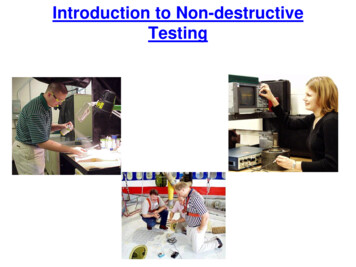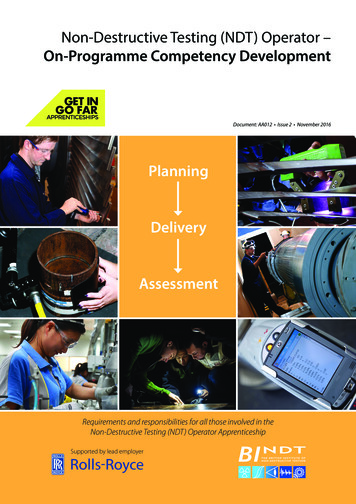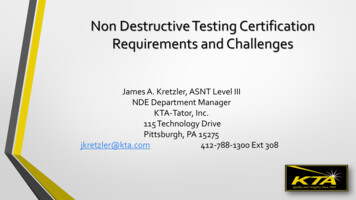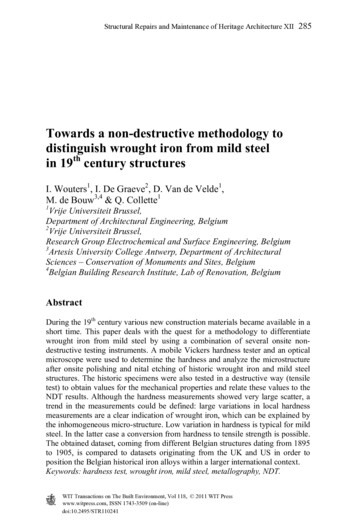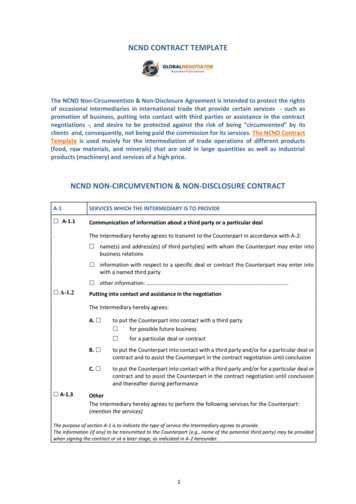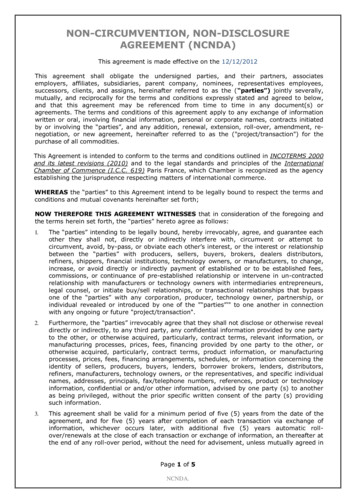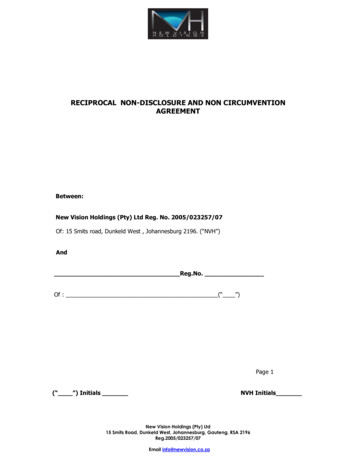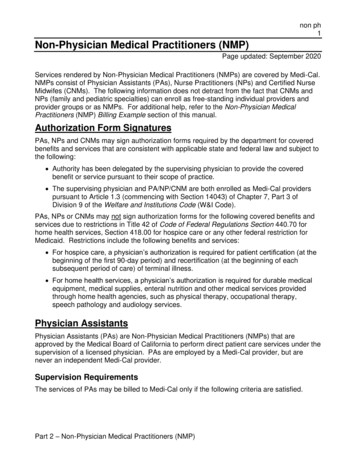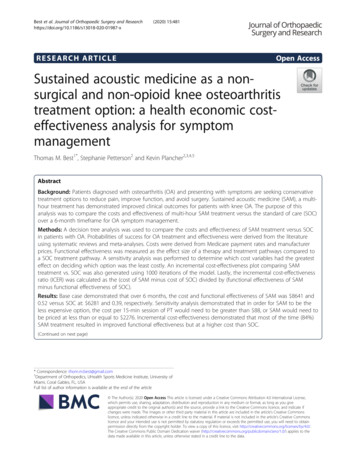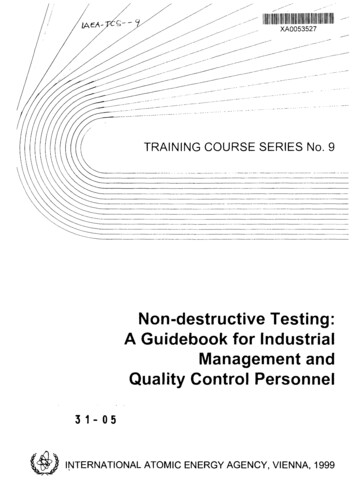
Transcription
TRAINING COURSE SERIES No. 9Non-destructive Testing:A Guidebook for IndustrialManagement andQuality Control Personnel3 1-05INTERNATIONAL ATOMIC ENERGY AGENCY, VIENNA, 1999
TRAINING COURSE SERIES No. 9Non-destructive Testing:A Guidebook for IndustrialManagement andQuality Control PersonnelINTERNATIONAL ATOMIC ENERGY AGENCY, VIENNA, 1999
The originating Section of this publication in the IAEA was:Industrial Applications and Chemistry SectionInternational Atomic Energy AgencyWagramer Strasse 5P.O. Box 100A-1400 Vienna, AustriaNON-DESTRUCTIVE TESTING: A GUIDEBOOK FORINDUSTRIAL MANAGEMENT AND QUALITY CONTROL PERSONNELIAEA, VIENNA, 1999IAEA-TCS-9 IAEA, 1999Printed by the IAEA in AustriaJanuary 1999
FOREWORDThe introduction and application of non-destructive testing (NDT) in industry is grosslymisrepresented and misunderstood. It is often said that introduction of this expensivetechnology does not give any tangible returns or at least does not give returns proportional tothe investment made. The facts, however, are exactly opposite to this notion and thinking. Infact, NDT, when appropriately applied, gives tremendous returns by way of savings in scrapby lowering the ultimate rates of rejection, saving valuable manufacturing time, increasing theoverall quality and reliability of manufactured goods, providing an extension of plant lifethrough preventive maintenance, saving unnecessary shutdowns, particularly through inservice inspection, and enhancement of a particular industry's reputation and consequentincreased sales and profits. Therefore, even from a purely commercial viewpoint, NDT is ofutmost importance for an industrial concern. The additional considerations of NDT's role insafety, failure and consequent accident prevention leave no doubt at all about the value andneed of NDT.It is this point that needs to be fully appreciated by the industrial managers and decisionmakers at all levels. Management ought to understand in quite an unambiguous way that theirproducts can only survive in the highly competitive markets of today if they have the adequateand optimum quality. This quality can be built into the manufactured goods only if suitablemeasures and methods of quality control are employed and that the most suitable methods inmost situations are the non-destructive testing methods.Experience shows that in many cases of industrial decision making, proper knowledge ofvarious aspects of a particular technology plays an important role. Therefore, if positivedecisions are desired to be taken in favour of introducing NDT in industry in any country, itsdecision makers should be properly equipped with knowledge and information about this areaof technology. It was with this thinking and background that training courses were organized,first in Pakistan, with the help of IAEA assistance. Each course was of two weeks durationand covered quite comprehensively various aspects of NDT technology. The topics selectedincluded NDT methods, their applications, capabilities and limitations; economic andadministrative aspects of NDT; codes and standards; quality assurance; education, trainingand certification of NDT personnel and sources of information in NDT. Variousmanufacturing processes and the typical defects associated with them were also reviewed. Thecourse also included demonstration practicals on all the basic five methods of NDT and, tokeep the managers interested and fully occupied, a token examination was given on the lastday. These courses were very well received and appreciated by all the participants, most ofwhom were the middle level managers in their industries. One indicator of the success andthe interest it generated was the demands from these managers for training of their staff inNDT. No doubt that two weeks proved to be too long a period for which the managementpersonnel could afford to be away from their establishments. Nevertheless, the topics coveredhave been found to be quite informative and of fundamental importance for impressing uponthe management personnel the importance and need for NDT. A shorter version of this can beextracted from these topics and given in the form of executive management seminars. It hastherefore been considered appropriate to compile the lectures delivered at these courses in theform of a book such as to make it suitable for use in the other countries of the region, as wellas other regions of the world.The IAEA expert for these training courses held in Pakistan was J. Zimhelt of Canada and thecontents of some of the sections are based on his lectures and are duly acknowledged. Some
portions of the book have been directly adopted from the Training Course Series No. 3entitled Industrial Radiography: Manual for the Syllabi Contained in IAEA-TECDOC-628,"Training Guidelines in Non-destructive Testing Techniques" (IAEA, 1992). The remainingsections were developed by A.A. Khan and his colleagues at the National Centre for NDT(NCNDT) of the Pakistan Atomic Energy Commission. Different sections of the book werethen sent to the national co-ordinators of the NDT sub-project of RCA in the region of Asiaand the Pacific for their comments and suggestions. The draft was then finalized byincorporating the recommended changes. During the process of compilation of the trainingnotes guidance and support were provided by a large number of persons, especially from theNCNDT, the OAEP, Thailand and the RCA Co-ordinator's office at the IAEA. The IAEAwishes to express its appreciation to all those who have contributed to the production of thesetraining course notes and to the governments and organizations whose financial and technicalsupport made this publication possible.EDITORIAL NOTEIn preparing this publication for press, staff of the IAEA have made up the pages from theoriginal manuscripts). The views expressed do not necessarily reflect those of the IAEA, thegovernments of the nominating Member States or the nominating organizations.Throughout the text names of Member States are retained as they were when the text wascompiled.The use of particular designations of countries or territories does not imply any judgement bythe publisher, the IAEA, as to the legal status of such countries or territories, of their authorities andinstitutions or of the delimitation of their boundaries.The mention of names of specific companies or products (whether or not indicated asregistered) does not imply any intention to infringe proprietary rights, nor should it be construed asan endorsement or recommendation on the part of the IAEA.
CONTENTS1.THE IMPORTANCE OF NON-DESTRUCTIVE TESTING1.1.The scope of NDT1.1.1.Need and definition of NDT1.1.2.Methods of NDT1.1.3.Relationship to destructive testingThe applications of NDT1.2.1.Applications in design1.2.2.Applications in manufacturing quality1.2.3.Applications for in-service inspection1.2.4.Applications in plant life extension1.2.5.Other applicationsThe impact of NDT in disaster prevention1.3.1.Loss of life1.3.2.Environmental damage1.3.3.Loss of product1.3.4.Lost time1.3.5.Repair costsThe historical development of NDT1.4.1.Factors influencing development1.4.2.Future ALS, MANUFACTURING PROCESSES AND DEFECTS132.1.Structure of metals and alloys2.1.1.Grains (crystals) and grain boundaries2.1.2.Structure of alloys2.1.3.Allotropic transformationPhysical and mechanical properties of metallic ity2.2.7.Notch toughness2.2.8.ConductivityBasic metallurgical processes and defects2.3.1.Welding processes2.3.2.Weld defects2.3.3.Casting processes2.3.4.Casting defects2.3.5.Forging processes2.3.6.Rolling processes2.3.7.Forging and rolling defects2.3.8.Surface finishingMaterials in service2.4.1.Behaviour of materials in service2.4.2.Conditions leading to defects and failuresNon-metallic 1.4.2.2.2.3.2.4.2.5.1
2.5.3.Composites612.5.4.Concrete633.THE TECHNOLOGY OF NDT METHODS3.1.3.8.3.9.Visual testing (VT)3.1.1.Tools for visual inspection3.1.2.Applications of visual inspectionLiquid penetrant testing (PT)3.2.1.General procedure for liquid penetrant inspection3.2.2.Penetrant processes and equipment3.2.3.Areas of application of liquid penetrants3.2.4.Range and limitations of liquid penetrantsMagnetic particle testing3.3.1.Methods of magnetization3.3.2.General procedure for magnetic testing3.3.3.Equipment for magnetic particle inspection3.3.4.Applications of the magnetic method of testing3.3.5.Range and limitations of magnetic particle inspectionEddy current testing3.4.1.Equipment and procedure for eddy current testing3.4.2.Applications of eddy current testing3.4.3.Range and limitations of eddy current testingRadiographic testing3.5.1.Fundamental principles3.5.2.General procedure for radiographic testing3.5.3.Different forms of radiographic testing3.5.4.Personal safety and radiation protection3.5.5.Applications of radiographic testing method3.5.6.Range and limitations of radiographic testingUltrasonic testing3.6.1.Fundamental principles3.6.2.Equipment for ultrasonic testing3.6.3.General procedure for ultrasonic testing3.6.4.Applications of ultrasonic testing3.6.5.Range and limitations of ultrasonic testingOther methods of NDT3.7.1.Acoustic emission3.7.2.Thermal methods3.7.3.Microwave testing3.7.4.Computer tomography3.7.5.Strain sensing3.7.6.Leak testing3.7.7.Radioisotope gauges3.7.8.Analytical methods3.7.9.Miscellaneous methodsFuture developments in NDTComparison and selection of NDT 211211221234.THE ECONOMIC ASPECTS OF NDT1264.1.Direct costs4.1.1.Capital equipment costs4.1.2.Consumables costs1261261273.2.3.3.3.4.3.5.3.6.3.7.63
4.3.4.1.3.Manpower costs4.1.4.Other costsDirect benefits4.2.1.NDT vs dismantling4.2.2.NDT and destructive tests4.2.3.NDT vs shutdown and replacementIndirect factors4.3.1.Cost of not doing NDT4.3.2.Cost of not doing NDT correctly4.3.3.Cost of fraud4.3.4.NDT and life cycle costs4.3.5.Costs related to accept/reject criteria4.3.6.Miscellaneous factors related to NDT costs1281281291301301311311321321331331331345.NDT AND QUALITY ASSURANCE1355.1.5.2.The need for quality assuranceBasic definitions related to quality assurance5.2.1.Quality5.2.2.Quality control5.2.3.Quality assurance5.2.4.Examination and que5.2.8.Report5.2.9.RecordsResponsibility for quality5.3.1.Inspection and test department5.3.2.Quality control departmentMethods for determining quality5.4.1.Statistical quality control5.4.2.Destructive tests5.4.3.Quality control applications of NDT5.4.4.InspectionQuality assurance5.5.1.Independence of quality assurance department5.5.2.Establishment of quality standards5.5.3.Written procedures5.5.4.Control of document flow5.5.5.Maintaining identity and traceability of materials5.5.6.Non-conforming material and corrective action5.5.7.Calibration of equipment5.5.8.Retention of records5.5.9.Personnel training and qualification5.5.10. Control of purchased material5.5.11. Manufacturing, assembly and packaging5.5.12. Quality 16.CODES AND STANDARDS AND THEIR IMPORTANCE IN NDT1636.1.The need for standards6.1.1.Variables in NDT6.1.2.Process of standardization1631631644.2.5.3.5.4.5.5.
6.1.3.Aims of standardizationDifferent categories of standards6.2.1.Guides and recommended practices6.2.2.Standards6.2.3.Codes and specifications6.2.4.StandardizationTypes of standards'.6.3.1.Standards for terminology6.3.2.Standards for equipment6.3.3.Standards for testing methods6.3.4.Standards for education, training and certification of NDT personnel6.3.5.Standards for acceptance and rejection6.3.6.Accreditation standardsSome standard issuing bodies and some of their standards related to NDT6.4.1.International Organization for Standardization (ISO)6.4.2.International Institute of Welding (IIW)6.4.3.British Standards Institution (BSI)6.4.4.Deutsches Institut fur Normen (DIN)6.4.5.Japanese Industrial Standards Committee (JISC)6.4.6.Standards Association of Australia (SAA)6.4.7.Standards Council of Canada6.4.8.American Society for Testing and Materials (ASTM)6.4.9.The American Society of Mechanical Engineers (ASME)6.4.10. Other standardization 91721731791841881891911992007.EVALUATION OF TEST RESULTS2007.1.7.2.Significance of defects and need for proper evaluation of NDT resultsDetermination of flaw characteristics in NDT7.2.1.Liquid penetrant testing7.2.2.Magnetic particle testing7.2.3.Eddy current testing7.2.4.Radiographic testing7.2.5.Ultrasonic testingAcceptance and rejection criteria7.3.1.Liquid penetrant testing7.3.2.Magnetic particle testing7.3.3.Eddy current testing7.3.4.Radiographic testingFlaw evaluation by fracture mechanicsNDT reports and records7.5.1.The test report7.5.2.Other 39240TRAINING, QUALIFICATION AND CERTIFICATIONOF NDT PERSONNEL243Importance of proper training and certificationInternational training and certificationIAEA experienceQualification to ISO standardInternational 5.8.8.1.8.2.8.3.8.4.8.5.
9.SOURCES OF INFORMATION IN ksNDT journalsConference proceedingsStandardsPatentsTechnical reportsProfessional NDT societies and experienced personnelCommunications with related personsAudiovisual aidsInformation systems and TION AND ADMINISTRATION OF NDT27010.1. Buying and supervising NDT services10.2. The special role of the level 3 in management10.3. Typical laboratory/service facility organization10.3.1. Typical laboratory and equipment l
The introduction and application of non-destructive testing (NDT) in industry is grossly misrepresented and misunderstood. It is often said that introduction of this expensive technology does not give any tangible returns or at least does not give returns proportional to the investment made. The facts, however, are exactly opposite to this notion and thinking. In fact, NDT, when appropriately .

